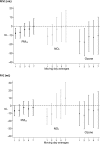Short-term exposure to air pollution and lung function in the Framingham Heart Study
- PMID: 24200465
- PMCID: PMC3919078
- DOI: 10.1164/rccm.201308-1414OC
Short-term exposure to air pollution and lung function in the Framingham Heart Study
Abstract
Rationale: Short-term exposure to ambient air pollution has been associated with lower lung function. Few studies have examined whether these associations are detectable at relatively low levels of pollution within current U.S. Environmental Protection Agency (EPA) standards.
Objectives: To examine exposure to ambient air pollutants within EPA standards and lung function in a large cohort study.
Methods: We included 3,262 participants of the Framingham Offspring and Third Generation cohorts living within 40 km of the Harvard Supersite monitor in Boston, Massachusetts (5,358 examinations, 1995-2011) who were not current smokers, with previous-day pollutant levels in compliance with EPA standards. We compared lung function (FEV1 and FVC) after previous-day exposure to particulate matter less than 2.5 μm in diameter (PM2.5), nitrogen dioxide (NO2), and ozone (O3) in the "moderate" range of the EPA Air Quality Index to exposure in the "good" range. We also examined linear relationships between moving averages of pollutant concentrations 1, 2, 3, 5, and 7 days before spirometry and lung function.
Measurements and main results: Exposure to pollutant concentrations in the "moderate" range of the EPA Air Quality Index was associated with a 20.1-ml lower FEV1 for PM2.5 (95% confidence interval [CI], -33.4, -6.9), a 30.6-ml lower FEV1 for NO2 (95% CI, -60.9, -0.2), and a 55.7-ml lower FEV1 for O3 (95% CI, -100.7, -10.8) compared with the "good" range. The 1- and 2-day moving averages of PM2.5, NO2, and O3 before testing were negatively associated with FEV1 and FVC.
Conclusions: Short-term exposure to PM2.5, NO2, and O3 within current EPA standards was associated with lower lung function in this cohort of adults.
Figures

References
-
- Sunyer J. Urban air pollution and chronic obstructive pulmonary disease: a review. Eur Respir J2001;17:1024–1033. - PubMed
-
- Brunekreef B, Holgate ST. Air pollution and health. Lancet. 2002;360:1233–1242. - PubMed
-
- Faustini A, Stafoggia M, Cappai G, Forastiere F. Short-term effects of air pollution in a cohort of patients with chronic obstructive pulmonary disease. Epidemiology. 2012;23:861–879. - PubMed
-
- Cakmak S, Dales R, Leech J, Liu L. The influence of air pollution on cardiovascular and pulmonary function and exercise capacity: Canadian Health Measures Survey (CHMS) Environ Res. 2011;111:1309–1312. - PubMed
Publication types
MeSH terms
Substances
Grants and funding
- 1R01HL70100/HL/NHLBI NIH HHS/United States
- P30 ES000002/ES/NIEHS NIH HHS/United States
- N01-HC 25195/HC/NHLBI NIH HHS/United States
- R01 HL060040/HL/NHLBI NIH HHS/United States
- N01 HC025195/HL/NHLBI NIH HHS/United States
- P30ES000002/ES/NIEHS NIH HHS/United States
- T32HL007374/HL/NHLBI NIH HHS/United States
- 1F32ES023352-01/ES/NIEHS NIH HHS/United States
- T32 HL007374/HL/NHLBI NIH HHS/United States
- 1R01HL60040/HL/NHLBI NIH HHS/United States
- R01 HL070100/HL/NHLBI NIH HHS/United States
- F32 ES023352/ES/NIEHS NIH HHS/United States
LinkOut - more resources
Full Text Sources
Other Literature Sources
Research Materials

